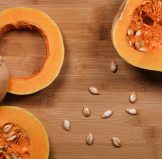
Butternut Squash
We’ve tried a number of ways to store squash, and we’ve been informed over the years by our friends at Seed Savers. If you’ve been canning, chopping and freezing, and cooking things down into sauce this harvest season, you’ll love the ease of storing winter squash whole.
First, be sure the squash are ripe. Each variety differs regarding color and sheen as indicators of ripeness, but as a rule we harvest when the thick stem connecting the fruit to the vine has dried. Cut the stem, leaving at least 1″ and up to 3″ of the stem attached. Be sure to harvest before the first hard frost – if you can’t harvest until after a frost, don’t try to cure and store the squash. Rather, either dice and freeze for later, or bake or make soup and freeze that for later.
Curing is a process that sets up the squash for several months’ of storage by allowing the skin, or shell, to harden. After harvest, elevate the squash off the ground, keeping room between fruits for air to circulate, and leave in a bright, sunny space that isn’t warm or hot for approximately two weeks. You’ll know when they are cured when they pass the ‘fingernail test’ – press your fingernail gently into the shell, and if the skin bruises or breaks, it’s not cured yet! A fully cured squash won’t even dent.
Storage instructions do sound a bit like the porridge in the Goldilocks story – the place you store the squash can’t be too hot or too cold. It needs to be just right! That means not colder than 50 degrees and not warmer than about 65 degrees. The warmer the temperature, the sooner you’ll need to use the squash. Find a cool spot in a closet, the back of a cupboard, a basement, or a garage (if it is temperature controlled). Wrap each squash in paper or straw and place in a box or on a shelf, leaving room for airflow. The paper or straw protects the squash and absorbs any moisture. If the squash does freeze, keep it frozen until you’re ready to use it. Inspect once a week, and use any damaged squash first. Here’s advice from Seed Savers:
- “Any damaged squash should be used as soon as possible.
- Delicatas, Acorns, and Buttercups should be used within a month or two.
- Hubbards, Pie squash, and pumpkins can last up to four months.
- Butternuts last the longest in storage and can take you right into spring.”
And if you don’t have the appropriate space, you can always preserve your squash by dicing and freezing the flesh.
Seed Saving – Seeds last up to a year in your squash – so whenever you use your squash you can scrape out the seeds, rinse and dry, and plant in the spring. Just be aware that squash is a notorious cross-pollinator, and if you grew several kinds you will not necessarily grow a fruit exactly like the one you harvested!
And yes, pumpkins ARE winter squashes. Save them using these same instructions.
